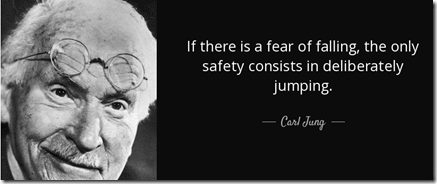Originally posted on February 21, 2016 @ 6:06 PM
C. G. Jung on Risk and Safety
 Jung was a Swiss psychiatrist and psychotherapist who has had a profound influence on western thought and practice (https://en.wikipedia.org/wiki/Carl_Jung ). His theory of archetypes is the foundation of the Myer-Briggs Type Indicator which is in constant use and has been undertaken by millions over the past 60 years. Regardless of the controversy surrounding the work of Jung, his work on the Collective Unconscious, archetypes and ‘complexes’ serve as useful tools for understanding human judgment and decision making. Similarly, Freud’s work on defense mechanisms, ego, id and super-ego (One Brain Three Minds https://vimeo.com/106770292 ) and the unconscious, have provided us with many useful ways of understanding decision making.
Jung was a Swiss psychiatrist and psychotherapist who has had a profound influence on western thought and practice (https://en.wikipedia.org/wiki/Carl_Jung ). His theory of archetypes is the foundation of the Myer-Briggs Type Indicator which is in constant use and has been undertaken by millions over the past 60 years. Regardless of the controversy surrounding the work of Jung, his work on the Collective Unconscious, archetypes and ‘complexes’ serve as useful tools for understanding human judgment and decision making. Similarly, Freud’s work on defense mechanisms, ego, id and super-ego (One Brain Three Minds https://vimeo.com/106770292 ) and the unconscious, have provided us with many useful ways of understanding decision making.
Unfortunately, Safety is commanded by the rationalist-materialist and reductionist-behaviourist paradigm (see Dekker http://sidneydekker.com/wp-content/uploads/2013/01/DekkerDriftRiskChapter2013.pdf). Any study of curriculum in risk and safety will demonstrate that the notion of the unconscious and non-conscious decision making is totally absent from safety discourse. For some reason Safety has been hi-jacked and evolved into a discipline of engineering and science. Indeed, just look at the 5 core units required in a Diploma in WHS and the absence of connection to any human skills and understanding decision making is apparent. Safety seems to be the only industry that prepares people to engage with objects not with subjects (people). Yet, I get inundated every day with safety people who want to learn more about human judgment and decision making, the psychology of risk and, understanding motivation, perception, goals and communication.
It was Jung’s work that brought back into discussion the importance of dreams, intuition, non-conscious knowledge, tacit thinking, imagination and heuristics. The rationalist-materialist and reductionist-behaviourist paradigm ushered in by Descartes and Newton banished such things to the scrap heap until revived by Freud and Jung in the early 2oth century. Strange, because every society prior to Descartes and Newton valued deeply the meaning of dreams, visions and the unconscious. Yet, in our private lives we are attracted to stories of the unconscious, the highest grossing movie in 2016 concerns the story of a group of people who believe in ‘the force’. The classics studied in all schools and universities, especially Shakespeare, maintain the importance of the unconscious. History is littered with world changing critical decisions being made on the basis of a dream (https://en.wikipedia.org/wiki/Nancy_Reagan ). Many of our great poets, musicians, composers, performers, artists and thinkers place great importance on transcendence and the unconscious. Many try to get into a state of unconscious influence through psychedelics. Yet in Safety, all decisions are made rationally and materially.
I was recently asked to undertake a MiProfile survey with an organization that has just embraced the trend in ‘hot desking’ and ‘clean desking’ (http://www.abc.net.au/radionational/programs/blueprintforliving/where-office-meets-prison/7120782). The idea that we are not greatly affected by social arrangements is a nonsense projected by the rationalist-materialist and reductionist-behaviourist mindset. The evidence shows that we are profoundly affected by our social context, this is the foundation of the social psychology of risk (https://safetyrisk.net/understanding-the-social-psychology-of-risk-and-safety/). For example: the challenges of getting kids out from behind screens and into play and activity are a huge challenge for the future (https://www.psychologytoday.com/blog/mental-wealth/201402/gray-matters-too-much-screen-time-damages-the-brain; http://theconversation.com/why-screen-time-before-bed-is-bad-for-children-46464 . It has also been demonstrated that hot desking increases risk aversion and limits creativity. For more on the trade-offs and by-products of ‘hot desking’ see below.
http://www.brw.com.au/f/video/national/clean_desks_kill_creativity_Aa6Le2NSTDWmZY6KDUXmmK
http://theconversation.com/mess-or-nest-do-clean-desk-policies-really-help-us-work-better-3037
https://bluenotes.anz.com/posts/2016/01/long-live-the-messy-desk/
https://www.linkedin.com/pulse/clean-desk-policy-please-think-twice-anetta-pizag
So whilst the rationalist-materialist and reductionist-behaviourist mindset is fixed on KPIs and objects (hazards), the social psychological paradigm knows than money is not a motivator over meaning and purpose in life. http://ideas.ted.com/what-motivates-us-at-work-7-fascinating-studies-that-give-insights/?utm_campaign=social&utm_medium=referral&utm_source=linkedin.com&utm_content=ideas-blog&utm_term=humanities People are not the sum of inputs and outputs. Human judgments and decisions are not just about rational and irrational decisions.
Thanks to Jung we now can give greater weight to the importance of imagination in risk and safety. How can someone know what a hazard is without imagination of how a human will interact with an object? Thanks to Jung we now know that extroversion and introversion change people’s modes of communicating and learning. How much of why safety inductions are so poor is due to the rationalist-materialist and reductionist-behaviourist paradigm? Data is not learning. Thanks to Jung we now know that many of the things that influence decisions and judgments are unseen and communicated unconsciously through signs, symbols and semiotics. How much does a symbol of absolutes drive the acceptance of bullying, sociopathy and tyranny in a culture? Thanks to Jung we can now value premonitions, tacit knowledge and the value of heuristics. How important is it to value that something doesn’t feel or look right? Thanks to Jung we now that synchronicity is critical in understanding causality and emergence (http://www.aiprinc.org/para-ac08_Storm_1999.pdf). How often does safety ‘construct’ cause, rather than ‘discover’ cause?
So these are just a few of the ways Jung can broaden and develop the narrow confines of the rationalist-materialist and reductionist-behaviourist mindset that constricts Safety. Once one steps outside the rationalist-materialist and reductionist-behaviourist construct one sees a whole new world of how safety can be done differently.



Do you have any thoughts? Please share them below